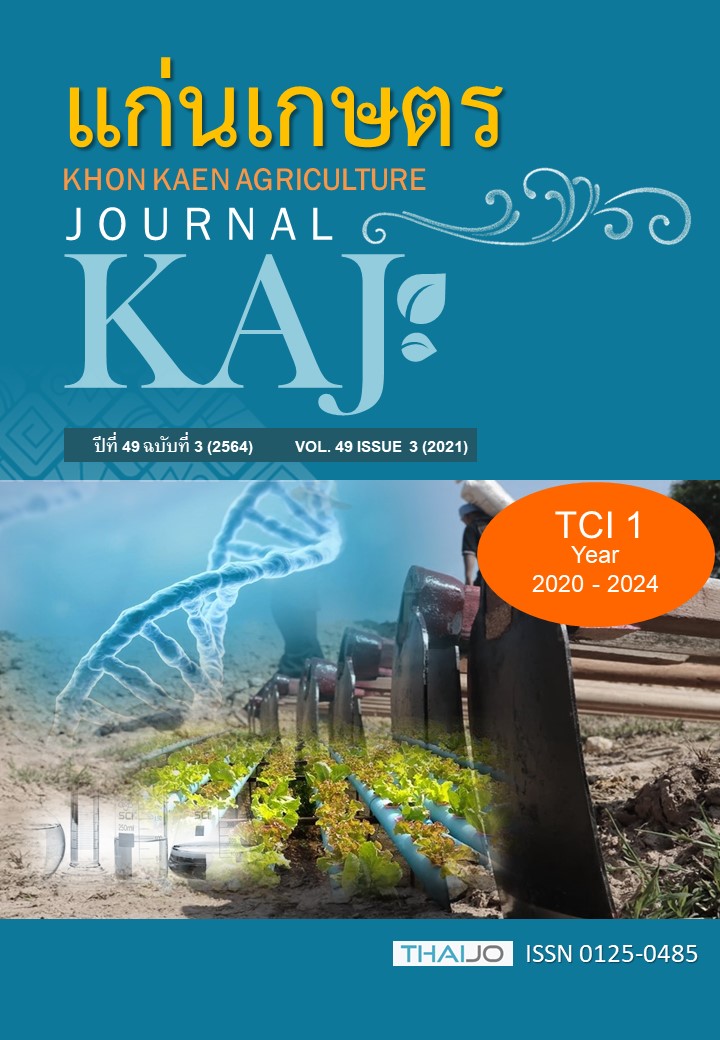ผลของปัจจัยแวดล้อมต่อการเจริญเติบโตของลิ้นจี่ ในพื้นที่จัดสรรเพื่อการเกษตร อุทยานแห่งชาติดอยสุเทพ-ปุย จังหวัดเชียงใหม่
Main Article Content
บทคัดย่อ
ระบบการเกษตรบนพื้นที่สูงมักประสบปัญหาผลผลิตตกต่ำ ซึ่งอาจเป็นเพราะการส่งเสริมการเขตกรรมที่ไม่สอดคล้องกับปัจจัยแวดล้อมที่พืชชนิดนั้นต้องการ งานวิจัยครั้งนี้มีวัตถุประสงค์เพื่อศึกษาถึงความสัมพันธ์ระหว่างปัจจัยแวดล้อมกับการเจริญเติบโตของลิ้นจี่ ในพื้นที่จัดสรรอุทยานแห่งชาติดอยสุเทพ-ปุย จังหวัดเชียงใหม่ โดยทำการวางแปลงขนาด 1 ไร่ (40x40 เมตร) 20 แปลงสำรวจ กระจายทั่วบริเวณพื้นที่ปลูกลิ้นจี่ของดอยสุเทพ-ปุย และรวบรวมข้อมูลปัจจัยสิ่งแวดล้อม ได้แก่ สภาพภูมิประเทศ และสมบัติของดิน หาความสัมพันธ์ต่อการเจริญเติบโต ผลการศึกษาพบว่า การเจริญเติบโตของลิ้นจี่มีความแตกต่างกัน โดยเฉพาะอย่างยิ่งมวลชีวภาพรวมมีความแตกต่างอย่างมีนัยสำคัญทางสถิติ เมื่อพิจารณาจากการจัดลำดับมวลชีวภาพตามปัจจัยแวดล้อมพบว่า ปัจจัยด้านความสูงจากระดับน้ำทะเล การไกลแหล่งน้ำตามธรรมชาติ และพื้นที่ลาดชันมีผลต่อมวลชีวภาพของลิ้นจี่สูง สอดคล้องกับการวิเคราะห์การระบุปัจจัยที่มีผลต่อการเจริญเติบโตด้านมวลชีวภาพของลิ้นจี่ โดยความสูงจากระดับน้ำทะเลที่ระดับมากกว่า 900 เมตร ความไกลแหล่งน้ำมากกว่า 0.4 กิโลเมตร มีผลในเชิงบวกต่อมวลชีวภาพของลิ้นจี่ ในขณะที่ปัจจัยด้านเนื้อดินที่มีปริมาณอนุภาคดินเหนียวมากกว่าร้อยละ 40 มีผลต่อการเจริญเติบโตด้านมวลชีวภาพในเชิงลบ ผลการศึกษาข้างต้นสามารถประยุกต์ไปสู่การเขตกรรมของการปลูกลิ้นจี่ให้มีประสิทธิภาพมากที่สุดโดยเฉพาะบนพื้นที่สูงในภาคเหนือของประเทศไทย
Article Details

อนุญาตภายใต้เงื่อนไข Creative Commons Attribution-NonCommercial-NoDerivatives 4.0 International License.
เอกสารอ้างอิง
สำนักงานเศรษฐกิจการเกษตร. 2562. ข้อมูลการผลิตสินค้าเกษตร-ลิ้นจี่. แหล่งข้อมูล: http://www.oae.go.th. ค้นเมื่อวันที่ 24 กุมภาพันธ์ 2563.
สุธีระ เหิมฮึก, วิชญ์ภาส สังพาลี, เนตรนภา อินสลุด, และจุฑามาศ อาจนาเสียว. 2559. ระบบการเกษตร และการพึ่งพาทรัพยากรป่าไม้ของชุมชนในอุทยานแห่งชาติดอยสุเทพ-ปุย จังหวัดเชียงใหม่. วิทยาศาสตร์เกษตร. 47(พิเศษ 2): 593-596.
สำเริง ปานอุทัย, สมชาย อ่อนอาษา, บุญมา ดีแสง, และต่อลาภ คำโย. 2562. ผลของการเปลี่ยนแปลงสิ่งปกคลุมดินต่อปริมาณน้ำในลำธาร พื้นที่สถานีวิจัยต้นน้ำแม่กลอง อำเภอทองผาภูมิ จังหวัดกาญจนบุรี. วารสารวิจัยนิเวศวิทยาป่าไม้เมืองไทย 3: 1-14.
Batten, D. J., C.A. McConchie, and J. Lloyd. 1994. Effects of soil water deficit on gas exchange characteristics and water relations of orchard lychee (Litchi chinensis Sonn.) trees. Tree Physiology. 14: 1177–1189.
Goswami, S., K.S. Verma, and R. Kaushal. 2013. Biomass and carbon sequestration in different agroforestry systems of a Western Himalayan watershed. Biological Agriculture & Horticulture. 30: 88-96.
Hermhuk, S., A. Chaiyes, S. Thinkampheang, N. Danrad, and D. Marod. 2021. Land use and above-ground biomass changes in a mountain ecosystem, northern Thailand. Journal of Forestry Research. 37: 1733-1742.
Kent, M., and P. Coker. 1994. Vegetation Description and Analysis. John Wiley and Sons, Chichester.
Kumar, M., V. Kumar, R. Prasad, and A. Varma. 2017. The Lychee Biotechnology (Edit.). Springer Singapore: Gateway East.
Marod, D., W. Phumphuang, T. Kamyo, J. Thongsawi, N. Khlangsap, S. Bootcharee, L. Asanok, S. Thinkampaeng, S. Hermhuk, and W. Nuipakdee. 2018. Diversity and spatial distribution of the Fagaceae tree species in the Doi Suthep-Pui Nationa Park. Journal of Tropical Forest Research. 2: 53-68.
Menzel, C. M. 2002. The Lychee Crop in Asia and the Pacific. Regional Office for Asia and the Pacific, Food and Agriculture Organization of the United Nations: Bangkok.
Naik, S. K., P. K. Sarkar, B. S. Das, A. K. Singh, and B.P. Bhatt. 2018. Predictive models for dry biomass and carbon stock estimation in Litchi chinensis under hot and dry sub-humid climate. Archives of Agronomy and Soil Science. 64: 1366-1378.
Pibumrung, P., N. Gajaseni, and A. Popan. 2008. Profiles of carbon stocks in forest, reforestation and agricultural land, Northern Thailand. Journal of Forestry Research. 19: 11-18.
Rerkasem, K., N. Yimyam, and B. Rerkasem. 2009. Land use transformation in the mountainous mainland Southeast Asia region and the role of indigenous knowledge and skills in forest management. Forest Ecology Management. 257: 2035-2043.
Ripley, B., B. Venables, D. W. Bates, K. Hornik, A. Gebhardt, D. Firth, and M. B. Ripley. 2013. Package ‘mass’. Cran R.Trisurat, Y., R. Alkemade, and P. H. Verburg. 2010. Projecting land-use change and its consequences for biodiversity in Northern Thailand. Environmental Management. 45: 626-639.
Yarnvudhi, A., S. Sungkaew, S. Hermhuk, P. Sunthornhao, and S. Onprom. 2016. Plant diversity and utilization on ethnobotany of local people at Hmong Doi Pui Village in Doi Suthep-Pui National Park, Chiang Mai province. Thai Journal of Forestry. 35: 136-146.
Yimyam, N., S. Lordkaew, and B. Rerkasem. 2016. Carbon storage in mountain land use systems in Northern Thailand. Mountain Research and Development. 36: 183-192.


